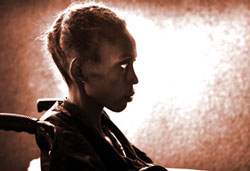By George Curry
-Guest Columnist-
You know an event is important when it takes on Roman numerals. It instantly achieves Super Bowl status. This year’s International AIDS Conference is number XVI. The one two years ago in Bangkok was XV. And the one two years from now, in Mexico City, will be XVII. This is the real Super Bowl. It’s not a game to crown a winner, but a gathering in search of a cure. Despite the worldwide attention, there isn’t any “cure” or vaccine on the horizon that will prevent HIV infections and other life-saving precautions will have to be accelerated.

Every two years, delegates assemble–this year, 24,000 of them from 153 countries –hoping against hope for a medical breakthrough. The official program book has 487 pages, enough to prop open a heavy door. It’s a big book for a big problem.
According to the World Health Organization, approximately 65 million people have been infected with HIV; AIDS has killed more than 25 million people since it was first reported in 1981. Since numbers can be cold and sometimes misleading, let’s break them down.
The 25 million deaths is the equivalent of the combined population of New York City, Los Angeles, Chicago, Houston, Philadelphia and Phoenix. Visualize everyone dying in those cities, the most populated in the U.S., and you begin to grasp the magnitude of the problem. And that doesn’t include the other 65 million infected, many of whom will also die. In 2005 alone, AIDS claimed 2.8 million people. In that same year, more than 45 million were infected.
Two-thirds of all people living with HIV (24.5 million) are living in sub-Saharan Africa, although that region has only 10 to 11 percent of the world’s population. On the other side of the Atlantic Ocean, Blacks make up 13 percent of the U.S. population, but 40 percent of 944,306 AIDS cases and 49 percent of cases diagnosed in 2004.
As Phill Wilson, founder and executive director of the Black AIDS Institute in Los Angeles, states: “AIDS is a Black disease.”
Not only is it a “Black” disease, it is increasingly a female disease. AIDS is the leading cause of death for Black women 25 to 34. Black women are 23 times more likely to have AIDS than White women. In the U.S., two-thirds of Black women are infected by heterosexual men. That’s not the down low–it’s low down.
It is also increasingly a youth disease, with half of the new HIV cases spreading among young people.
By 2005, AIDS had left more than 15 million children under the age of 18 orphaned, 12 million of them in sub-Saharan Africa. More than nine out of 10 children become inflected with HIV through mother-to-child transmission, either during pregnancy, childbirth or breastfeeding.
On the financial front, there is good news and bad news. The good news is that total AIDS funding is on the increase, rising from $8.3 billion in 2005 to $8.9 billion in 2006 to $10 billion in 2007. The bad news? That’s not enough. UNAIDS estimates that $14.9 billion is needed this year and $22.1 billion in 2008.
If there is any good news on the AIDS front, it’s that people such as Phill Wilson, founder of the Black AIDS Institute, and Pernessa Seele, president and CEO of the Balm in Gilead, have done a remarkable job mobilizing Black leaders and ministers, making sure that they don’t dismiss AIDS as a “gay disease.”
Appearing here to support Mr. Wilson’s call to arms were Julian Bond, chairman of the NAACP’s board of directors; Representatives Maxine Waters, Barbara Lee and Donna Christensen; business leader Sheila Johnson, activist Danny Bakewell, Hollywood’s Bill Duke and Sheryl Lee Ralph, Cheryl Cooper of the National Council of Negro Women, Jerry Lopes of National Urban Radio Networks and many more.
As is evident by so many people converging on Toronto from so many places, the HIV and AIDS epidemic takes on so many forms in different countries. According to Human Rights Watch, 3,000 people die each week in Zimbabwe because of “governmental policies that create formidable obstacles to accessing life-saving treatment.” The group says thousands of Romania children and youth living with HIV face widespread discrimination that “keeps many from attending school, obtaining necessary medical care, working or even learning about their disease.”
Additionally, Human Rights Watch reports, “The AIDS pandemic is fueled by a wide range of human rights violations, including sexual violence and coercion faced by women and girls, and abuses against men who have had sex with men, sex workers and injecting drug users… HIV spreads with frightening efficiency due to sexual violence, lack of access to condoms, lack of harm reduction measures for drug users and lack of information.”
The theme of this year’s conference is “Time to Deliver.” And that time cannot come soon enough.
(George Curry is editor-in-chief of the NNPA News Service and BlackPressUSA.com. He may be contacted via his website at www.georgecurry.com.)












